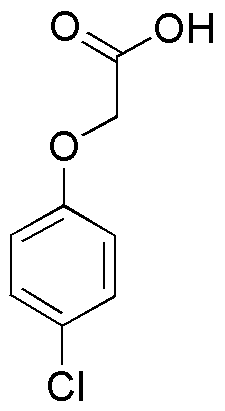4-Chlorophenoxyacetic acid is widely utilized in research focused on:
- Herbicide Development: This compound serves as a key ingredient in selective herbicides, effectively controlling broadleaf weeds in crops while minimizing harm to grasses, making it invaluable for agricultural applications.
- Plant Growth Regulation: It acts as a plant growth regulator, promoting root development and enhancing overall plant health, which is particularly beneficial in horticulture and forestry.
- Biochemical Research: Researchers use it to study plant hormone interactions, particularly in the auxin pathway, helping to unravel complex plant growth processes.
- Pharmaceutical Applications: The compound is explored for its potential therapeutic effects, including anti-inflammatory properties, which could lead to new treatments in medicine.
- Environmental Monitoring: It is utilized in studies assessing the environmental impact of herbicides, aiding in the development of safer agricultural practices and sustainable farming.
Información general
Propiedades
Seguridad y normativas
Aplicaciones
4-Chlorophenoxyacetic acid is widely utilized in research focused on:
- Herbicide Development: This compound serves as a key ingredient in selective herbicides, effectively controlling broadleaf weeds in crops while minimizing harm to grasses, making it invaluable for agricultural applications.
- Plant Growth Regulation: It acts as a plant growth regulator, promoting root development and enhancing overall plant health, which is particularly beneficial in horticulture and forestry.
- Biochemical Research: Researchers use it to study plant hormone interactions, particularly in the auxin pathway, helping to unravel complex plant growth processes.
- Pharmaceutical Applications: The compound is explored for its potential therapeutic effects, including anti-inflammatory properties, which could lead to new treatments in medicine.
- Environmental Monitoring: It is utilized in studies assessing the environmental impact of herbicides, aiding in the development of safer agricultural practices and sustainable farming.
Documentos
Hojas de datos de seguridad (HDS)
La SDS proporciona información de seguridad completa sobre la manipulación, el almacenamiento y la eliminación del producto.
Especificación del producto (PS)
La PS proporciona un desglose completo de las propiedades del producto, incluida la composición química, el estado físico, la pureza y los requisitos de almacenamiento. También detalla los rangos de calidad aceptables y las aplicaciones previstas del producto.
Certificados de análisis (COA)
Busque certificados de análisis (COA) ingresando el número de lote del producto. Los números de lote y de partida se pueden encontrar en la etiqueta de un producto después de las palabras "Lote" o "Lote".
Número de catálogo
Número de lote/lote
Certificados de origen (COO)
Este certificado de origen confirma el país en el que se fabricó el producto y también detalla los materiales y componentes utilizados en él y si se deriva de fuentes naturales, sintéticas u otras fuentes específicas. Este certificado puede ser necesario para cumplir con las normativas aduaneras, comerciales y regulatorias.
Número de catálogo
Número de lote/lote
Hojas de datos de seguridad (HDS)
La SDS proporciona información de seguridad completa sobre la manipulación, el almacenamiento y la eliminación del producto.
DownloadEspecificación del producto (PS)
La PS proporciona un desglose completo de las propiedades del producto, incluida la composición química, el estado físico, la pureza y los requisitos de almacenamiento. También detalla los rangos de calidad aceptables y las aplicaciones previstas del producto.
DownloadCertificados de análisis (COA)
Busque certificados de análisis (COA) ingresando el número de lote del producto. Los números de lote y de partida se pueden encontrar en la etiqueta de un producto después de las palabras "Lote" o "Lote".
Número de catálogo
Número de lote/lote
Certificados de origen (COO)
Este certificado de origen confirma el país en el que se fabricó el producto y también detalla los materiales y componentes utilizados en él y si se deriva de fuentes naturales, sintéticas u otras fuentes específicas. Este certificado puede ser necesario para cumplir con las normativas aduaneras, comerciales y regulatorias.


